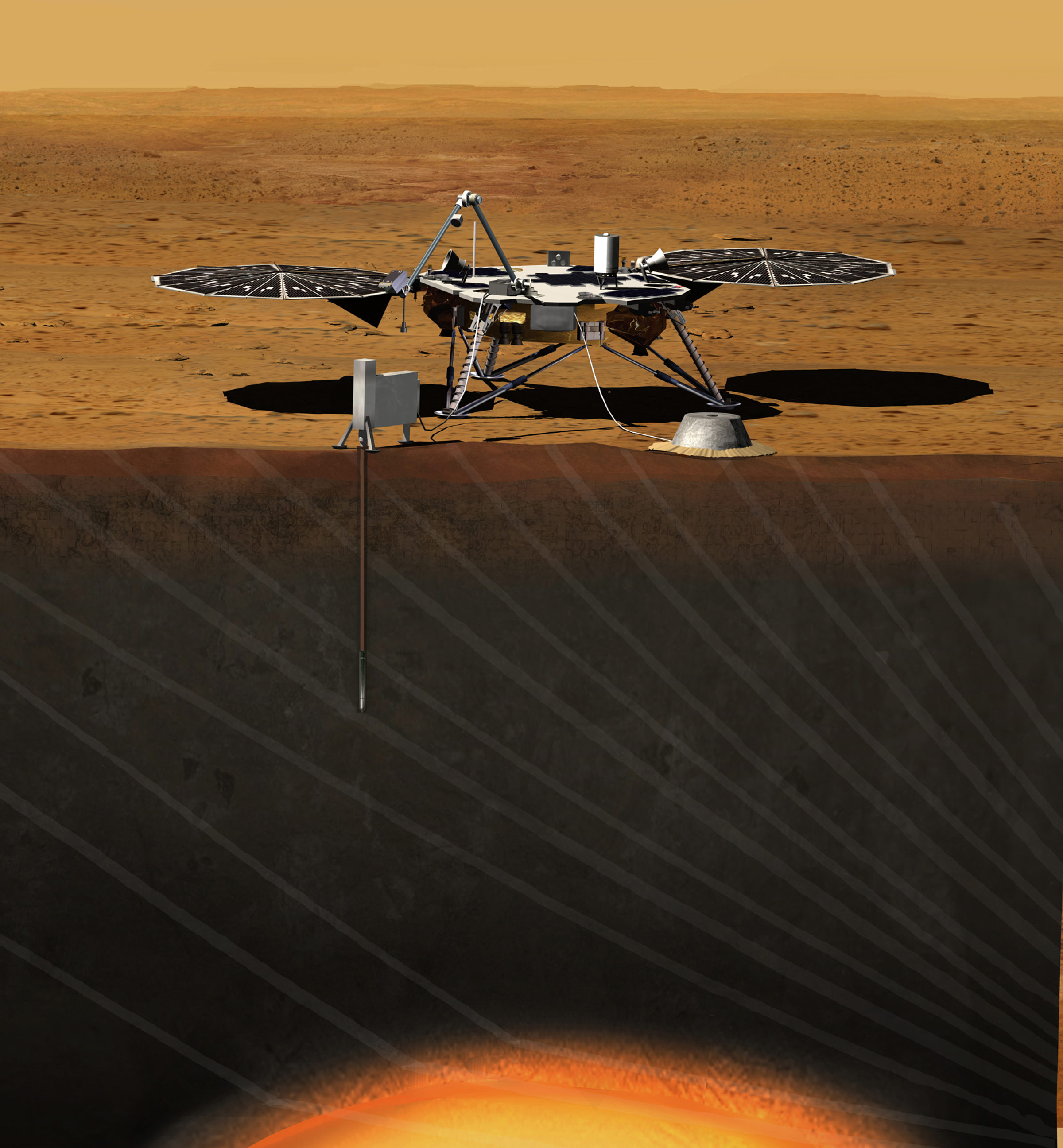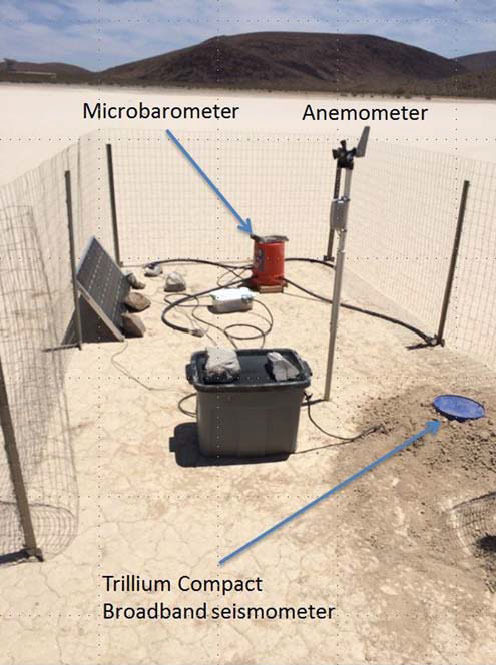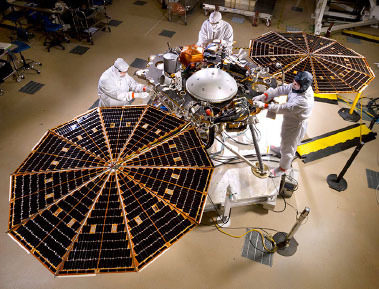Ralph Lorenz • Nov 11, 2015
Detecting Dust Devils with Insight
I had been studying dust devils for many years, and had some familiarity with the statistics of Martian wind speeds, and a couple of years ago I was asked to help assess the wind noise estimates for the InSight mission. (Ironically, I had been working on the Titan Mare Explorer, which had been competing against InSight in the last NASA Discovery mission selection. Many of the issues of vehicles interacting with a planetary environment are common – I often get the fun job of trying to understand what the systems and instruments we design will 'feel' on other worlds.) It had occurred to me, and to others, that perhaps InSight's sensitive seismometer might be able to detect dust devils – and at the very least, dust devils might contribute to the noise background against which marsquakes might be detected.

At the noise model review at JPL in November 2013, I welcomed the InSight team's plans to test a seismometer in 'field conditions' outdoors. Unlike the rather simple instrument on the Viking lander, the ultra-sensitive InSight seismometer will be placed directly on the ground on Mars, and will be protected by a wind and thermal shield. Still, it will not be deeply buried in a concrete vault, as conventional Earth-based seismic stations are. This makes the InSight seismometer susceptible to surface tilt effects due to wind stresses and horizontal variations in atmospheric pressure. In fact, when I made a study of seismic noise backgrounds in connection with a Venus lander study a few years ago, I found the most useful data on these effects were not in traditional geophysics papers but in the literature on military applications of seismology – in perimeter security and treaty verification, where understanding such noise is particularly important. For example, seismometers were air-dropped on the Ho Chi Min trail to detect enemy supply convoys in the Vietnam war, and a world-wide network of seismic and infrasound stations is operated by the Comprehensive Test Ban Treaty Organization (CTBTO) to detect clandestine nuclear explosion tests.) I had fun showing the disturbances from distant earthquakes, from the astronauts ascending the ladder of the Apollo lunar module, and a nearby Leopard 1 main battle tank all on the same plot.
Anyway, while the Noise Model Review did – as such reviews often do – a fine job of addressing the "known unknowns", such a field test offered the possibility to flush out really unexpected effects, which I thought to be very important. As I found when putting together a book on Space Systems Failures, you don't know what you don't know, and that's what usually catches you. The tests also offered the prospect of getting seismic data in a setting where dust devils would be present, and I offered to help by augmenting their field installation with an array of pressure loggers that I've used in previous dust devil surveys (e.g., a study with Brian Jackson) we showed how many 'dustless' vortices there are compared with dust devils.
The French-led seismometer team, under the leadership of principal investigator Philippe Lognonné, at the Institut de Physique du Globe in Paris, had anticipated that there would be significant atmospheric effects on the seismometer. Indeed, the InSight mission includes wind, pressure and magnetic field sensors to document these environmental variables. These sensors will provide an interesting and powerful record of the meteorological and magnetic environment in their own right. They are also critical for subtracting out these noise effects from the seismometer signal.
In particular, wind causes the solar arrays to flap slightly, and wind pushes sideways on the lander, causing different loads on its three feet. These varying loads cause the ground to deform slightly, which appears as a tilt signal on the seismometer. Similarly, variations in the atmospheric pressure cause small deformations on the ground, since pressure is simply the weight of the air column.


Embraced by the seismometer team as a Collaborator (albeit an unfunded one), I had the opportunity to look through the seismic data together with Sharon Kedar of the Jet Propulsion Laboratory, who led the testing campaign. The campaign was performed on a playa in Southern California at the Goldstone Deep Space Network station. He looked in the seismic record, and I examined the data from my pressure loggers. While there were many seismic events (with a variety of causes, not always known – Goldstone is in the Ft. Irwin military training area), and many dust devil vortices in the pressure data, matching them up was complicated by the fact that the data were recorded on different systems which were not perfectly synchronized. But a pair of vortices ten minutes apart, recorded at 23.13 UT on DOY 176 of 2014 (late in the afternoon California time on June 27) made a perfect fingerprint that could be matched up in both datasets.

My pressure loggers, distributed in a cross formation about 60 meters in cardinal directions from the seismic station (you can actually just see them as dark dots near the seismic instrument corral in Google Earth if you go to 35.418997°N 116.905801°W - you'll need to use the historical imagery tool to slide back to summer of 2014 – if you zoom out you'll see the 70m Deep Space Communication dish) all showed a deep (1.5 mbar) pressure drop, lasting about a minute, followed by another shallower dip. The fact that all loggers showed it means it was a rather large vortex, perhaps 100 meters in diameter or so, and close analysis suggested it passed from the west to the east, somewhat south of the seismometer.

The seismometer indicated a horizontal acceleration of about 2 microns per second squared (or 0.2 micro-g) – in other words a tilt of about 12 millionths of a degree. Just from the units you can tell what a sensitive measurement this is! The North-South axis showed a somewhat symmetric dip, while the East-West had more of a 'heartbeat'.
A little thought explains this effect. The dust devil vortex is a low-pressure system. A 1 mbar pressure drop in SI units is 1 hectoPascal, or 100 Pascals. 1 Pascal is 1 Newton per square meter, where 1 Newton is about the weight of an apple. Thus on every square meter of ground inside the dust devil, there is 100 N less weight of air pushing on the ground than elsewhere. Add that up over a dust devil say 10m in diameter, and you have about 10,000 N, or the weight of a small car. So a large dust devil can cause a very significant change in the loading of the ground, and it is no surprise the ground deforms by a tiny amount. In essence, the dust devil sucks on the ground, pulling it upwards like a tablecloth pinched between thumb and forefinger. So the ground tilts away from the dust devil.
Naomi Murdoch, a postdoc working in France on the InSight seismometer team, put together a model of this tilt, using classical theory on elastic deformations. From a seismic survey done at the playa, we had a good idea of the rigidity of the playa sediments. They make for a rather soft material, geologically speaking, and perhaps not too unlike the regolith we expect to land on at Elysium on Mars. We pretended the dust devil acted as a point load, equal to the pressure drop integrated over an area (the pressure drop actually declines smoothly with distance from center), which allowed an analytic solution to the deformation problem. And it seemed that the numbers added up: we could fit the observed tilt with quite reasonable parameters.
As for the shape of the tilt signatures, assuming the dust devil moved in a straight line (actually many follow slightly cycloidal paths), then in the cross-track direction, the seismometer tilts more and more towards the close-approach point, and then settles back as the devil gets further away. In the along-track direction, the seismometer tilts more and more towards the oncoming devil, then at closest approach must snap over into the opposite (downwind) direction before relaxing back to vertical as the devil recedes. The signals from the two seismometer axes (which may be in an arbitrary direction relative to the dust devil path) are a combination of these two.

In addition to the tilt signal, there are also short-period fluctuations in the seismic data (and in pressure data. In fact Doug Christie and I documented earlier this year just such fluctuations in infrasound records at the CTBTO station in Australia. These fluctuations are presumably caused by azimuthal variations in dust devil structure: that is, they are not perfectly circularly-symmetric. Indeed, early dust devil observers noted that multiple cores can exist, dancing around in a circle like Dervishes. But analyzing these – we are still at the trophy-hunting stage - will be a job for another day.
On the other hand, the overall tilt signal is something we can use right away. We can describe the tilt signal with a quantitative model to infer the encounter geometry of individual dust devil encounters. We can also probe the elastic properties of the Martian near-surface, treating the dust devils either as an aggregate population, or looking at individual encounter in conjunction with independent constraints on the encounter geometry from a camera, pressure and wind sensors. Our study was published this week in Bulletin of the Seismological Society of America.
Will InSight encounter dust devils? Well, first of all, this exercise doesn't need dust devils as such, only the vortices. The Opportunity rover did not see any dust devils, but this could be due to the availability of dust, rather than a lack of vortices. Unfortunately because the Mars Exploration Rovers were not equipped with even the most rudimentary meteorological instrumentation, we'll never know for sure. Spirit, on the other hand, saw many with its camera; its landing site at Gusev evidently had both large vortices and available dust. Phoenix and Pathfinder saw many and also detected vortices with pressure sensors. Interestingly, the landscape geometry and wind environment of the Curiosity landing site at Gale Crater appears not to favor formation of large vortices – its pressure sensors have detected many small ones, and only one dust devil has actually been seen.
But actually we know that dust devils must occur at InSight's Elysium landing site, because they have left their trails. When there is a thin layer of bright dust on darker underlying material, a dust devil can lift the dust along its path, leaving a dark trail. Not all vortices are dust devils, and not all dust devils leave trails, but if trails are seen from orbit, it's a sure thing that devils must have passed. Dennis Reiss at the University of Muenster and myself examined orbital images of the InSight landing sites and found that tracks were quite common, albeit generally smaller than those seen at the Gusev landing site of Spirit.


While on Earth dust devils are generally just an occasional nuisance and meteorological curiosity, on Mars, they are major agents of dust-raising, which is a major factor in the climate, and in the operation of solar-powered vehicles on Mars. In addition, their tracks can accumulate to cause appreciable albedo (reflectivity) changes over large regions, which may cause year-to-year variations in Mars' otherwise fairly uniform climate (which lacks the 'memory' of heat stored in our oceans, which is the major cause of interannual variations like El Niño on Earth) . Not only will InSight's meteorology measurements and cameras provide an opportunity to study them, but – perhaps surprisingly – so will its main experiment, the broadband seismometer.
Let’s Go Beyond The Horizon
Every success in space exploration is the result of the community of space enthusiasts, like you, who believe it is important. You can help usher in the next great era of space exploration with your gift today.
Donate Today

 Explore Worlds
Explore Worlds Find Life
Find Life Defend Earth
Defend Earth

